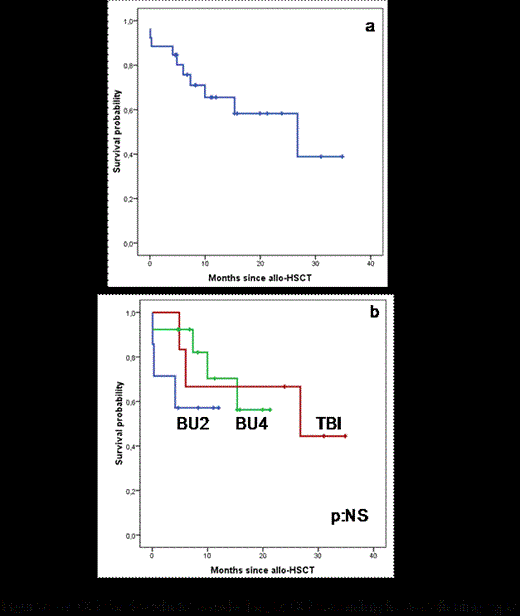Abstract
Advances in chemotherapy have improved the prognosis of patients with acute myeloid leukemia (AML), however, high-risk patients still have a poor outcome. In this category of patients, the only therapeutic strategy with curative potential remains allogeneic hematopoietic stem cell transplantation (allo-HSCT). With the aim to improve the effect of allo-HSCT by sequential use of chemotherapy followed by reduced intensity conditioning (RIC), we conducted a prospective pilot study in high-risk AML patients in first complete remission (CR1). The high-risk population included intermediate II [t(9;11)(p22;q23); MLLT3-MLL, cytogenetic abnormalities not classified as favorable or adverse] and unfavourable patients [inv(3)(q21q26.2) or t(3;3)(q21;q26.2); t(6;9)(p23;q34); t(v;11)(v;q23); MLL rearranged, -5 or del(5q); -7; abnl(17p); complex karyotype] (Dohner et al. Blood 2010), secondary AML, and patients requiring 2 induction courses to obtain CR. The chemotherapy sequential regimen consisted in fludarabine 30 mg/m2, high-dose cytarabine 2 g/m2, and amsacrine 100 mg/m2 from days -12 to -9 (FLAMSA). After 3 days of rest, RIC consisted of 4 Gy total-body irradiation (TBI) on day -5, cyclophosphamide (40 mg/kg with HLA-identical sibling, 60 mg/kg for unrelated or mismatched donors) on days -4 and -3, and rabbit antithymocyte globulin (ATG, Genzyme) (5 mg/kg total dose) from day -3 to day -1. As a new experimental approach, we replaced TBI by iv. busulfan (BU) (Busilvex, Pierre Fabre) 3.2 mg/kg/d during either 4 or 2 days according to patient age (>55 years) (from day -7 to -4 or from day -5 to -4). Peripheral-blood stem cells (PBSC) were preferred; bone marrow (BM) and cord blood (CB) were also accepted. Graft-versus-host disease (GvHD) prophylaxis consisted in ciclosporine from day -1, and mycophenolate mofetil (15 mg/kg bid), starting from day 0. In the absence of GvHD, MMF was discontinued by day+50 and ciclosporine was tapered from day +60 to +90. Except for cord blood transplantation, patients received 3 prophylactic increased doses of donor lymphocyte infusions (DLI) if they were in CR and GvHD-free at day +120 or 30 days after discontinuation of immunosuppressive agents starting at 1x106 CD3+ cells/kg. Between August 2010 and March 2013, 26 consecutive AML patients in CR1 were included; 11 males and 15 females with a median age at allo-HSCT of 55 years (range: 24-67), 19 (73%) were de novo AML and 7 (27%) secondary AML. According to cytogenetics and molecular markers, 22 (85%) were unfavourable and 4 (15%) were in intermediate II category. Before allo-HSCT, to reach CR1, 20 (77%) patients received one induction chemotherapy and 6 (23%) needed 2 inductions. Cell source was PBSC for 23 (88%) patients, CB for 2 and BM for 1 patient. Donors were 10/10 HLA matched siblings in 9 (35%) patients, 10/10 HLA matched unrelated in 8 (31%) patients and HLA mismatched for the rest of patients [unrelated 9/10 (n=7), CB 4/6 (n=2)]. For ABO compatibility, 13 (50%) were compatible, 5 (19%) had minor incompatibility and 8 (31%) had major incompatibility. For conditioning, 6 (23%) patients received TBI, 13 (50%) received 4 days BU and 7 (27%) received 2 days BU. After transplantation, 23 (88%) patients engrafted, 3 patients died early (1 at day 1 and 1 at day 2 both from septic shock; 1 at day 8 from pneumonia and pericardial effusion). At day 90 post-allo-HSCT, 18 (78%) showed total donor chimerism and 5 (22%) had mixed chimerism and all patients were in CR. There were 6/23 (26%) patients with acute GvHD [2 gr I, 2 gr II and 2 gr III] and 5/23 (22%) chronic GvHD [4 limited and 1 extensive], all before DLI. After a median follow-up of 9 months (range: 0.03-35), the 2-years probability of overall survival (OS) for the whole population was 58% (confidence interval: 47-69) (Figure 1a) and the 2 years cumulative incidence of relapse was 18% (confidence interval: 17-19). At the latest follow-up, 16/23 (70%) engrafted patients were alive, 4/23 (17%) patients relapsed and died later and 3/23 (13%) patients died from transplant related infectious complications. No statistical difference in terms of OS and relapse incidence was found between the 3 types of conditioning, (Figure 1b).
FLAMSA-RIC regimen followed by allo-HSCT showed promising results in high-risk CR1 AML patients. Because of some early severe infections, an efficient prophylactic anti-infectious strategy is recommended. The use of BU instead of TBI does not impact on transplant outcomes.
Disclosures:
No relevant conflicts of interest to declare.
Author notes
*
Asterisk with author names denotes non-ASH members.
© 2013 by The American Society of Hematology
2013


